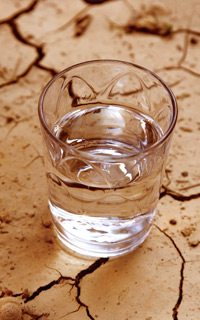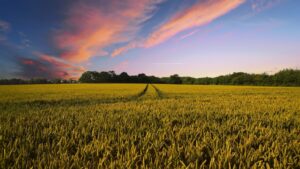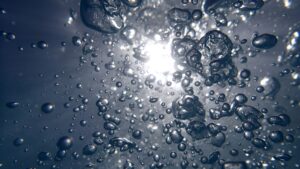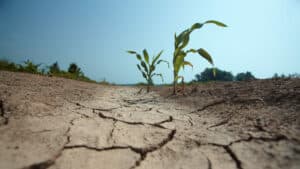Growing More with Less: Already a Reality in Our Backyard
Declining water availability in the United States and less productive land for agriculture across the country are driving an increased need to produce greater yields with less resources. Thankfully, the U.S. seed industry is already rising to the challenge.
The United Nations estimates that by the year 2030 the world will need 30 percent more fresh water and 50 percent more energy, and that by 2050 we will need 70 percent more food. Those are pretty daunting numbers, but what it really boils down to is the agricultural sector must produce more with less.
Talk of diminishing resources for agriculture is global in scope—we have all heard about severe droughts in Africa and expanding urban areas in China—but what’s the situation in the United States today?
Jim Gaffney, global biotechnology affairs and regulatory lead for agronomic traits for DuPont Pioneer, says both diminished land and water resources are critical issues in the United States.
“Many surface and groundwater resources throughout the United States are under pressure from a combination of industry, municipalities and agriculture,” he says. “Recent droughts, especially in the High Plains of the United States, have impacted farmers who draw water from the Ogallala Aquifer, and created even more pressure to use our water resource more carefully.”
Gaffney says limited water is impacting some areas more than others. “The Central Valley of California would be a case in point, where both farmers and urban dwellers depend on the melting snowpack from the Sierra Nevada Mountains for their water supply. In drought years, like we are now experiencing, agriculture suffers.”
As for land, Gaffney says there is evidence that “urban development is displacing production agricultural land” in some areas of the country. In fact, according to 2007 land use data from the U.S. Department of Agriculture, the total land area of the United States is 2.3 billion acres; of this, 17.7 percent, or 406 million acres, is cropland. This represents a decrease in American cropland from the USDA’s 2002 land use figures, which showed cropland comprising 19.5 percent of the total land area, or 442 million acres.
Integrated Solutions Already Here
According to Otto Doering, a professor in the department of agricultural economics at Purdue University, answering the challenge of diminished land and water resources in the United States is simple: “We will have to increase productivity on existing cropland acres and cannot count on additional acres coming in unless at great cost environmentally and financially.”
This need to increase productivity—or produce more with less—is already having an impact on the seed industry in the U.S. All of the major seed companies, as well as a variety of specialized trait developers, are pledging a greater focus on improving water use and improving yields and have incorporated that into their R&D programs.
“The issues of declining water availability and increased usage of less productive land, as well as variable weather patterns, all drive an increased need for integrated production solutions which combine superior genetics, crop protection and crop management to deliver better yield stability,” says Dan Dyer, global head for corn seed R&D at Syngenta.
The challenges of diminishing water availability for agriculture have led Syngenta to “rethink water,” says Dyer, adding “the Syngenta crop teams have established ‘water optimization’ and ‘land optimization’ as two areas of primary strategic focus.”
“While agricultural land availability has diminished in some areas, primarily due to urbanization, the greater impact has been the demand on U.S. agricultural productivity to meet the growing needs for food, feed, fuel and fiber.”
— Dan Dyer
Increasing Productivity
The main issue at stake is increasing productivity. “While agricultural land availability has diminished in some areas, primarily due to urbanization, the greater impact has been the demand on U.S. agricultural productivity to meet the growing needs for food, feed, fuel and fiber; which is driving the need for expanded acreage,” says Dyer.
“The combined U.S. acreage of the major row crops—corn, soy and wheat—increased from 216 million [acres] in 2000 to 230 million in 2012, according to the USDA’s National Agricultural Statistics Service. To meet the demand, growers are returning to production some marginal acreage that had been idled from production in previous decades. This has driven the development and commercialization of a range of yield-maximizing technologies,” Dyer adds.
As a result of these new technologies, the U.S. seed industry has already been successful at producing more with less in recent years. “Production agriculture has achieved much success in increasing productivity,” says Gaffney. “This success will serve as a foundation for continued improvement and future success.”
Gaffney lists the following examples of advancing productivity in the United States:
• Forty percent more maize is produced per acre today in the U.S. with the same amounts of nitrogen and available water as 25 to 30 years ago.
• Average U.S. corn yields in 2012, a season plagued by drought across the country, averaged about 123 bushels per acre—higher than non-drought years less than 25 years ago.
• U.S. maize production has one of the smallest water footprints of any grain crop around the world.
• In irrigated regions, such as Nebraska, farmers commonly produce 200 bu/acre corn with efficient irrigation and use of inputs and tillage.
“Corn farming, as both a science and an art, successfully adapts to a myriad of environmental challenges every year and, together with technology innovators like Syngenta, will continue to do so long into the future,” wrote Chuck Lee, head of corn for Syngenta, in a recent letter to the editor that appeared on SeedQuest.com. “For example, new irrigation and crop production technologies are enabling farmers in the western Corn Belt to maintain their yields while reducing water use by 25 percent, which is approximately five acre-inches or the equivalent of approximately 136,000 gallons per acre.”
Water Optimization Technologies
Perhaps the biggest breakthrough for increasing productivity has been advances in plant breeding, which have enabled researchers to identify and select genes that work to help plants use water more efficiently and provide season-long defense against drought.
For example, Syngenta has developed Agrisure Artesian technology in which “corn hybrids are bred, tested and selected to provide up to 15 percent higher yield under moderate to severe drought stress, without sacrificing high-end yield under the best conditions,” says Dyer, adding similar product types are under development for other crops.
“In addition, Avicta Complete Corn, Clariva Complete Beans, Vibrance and Agrisure Duracade are all recent product releases from Syngenta which support the establishment and maintenance of healthy crop root systems, which is critical for optimizing water usage,” he says. “Also, growers participating in the Water+ Intelligent Irrigation Platform—our integrated solution for water and crop management for irrigated corn—have demonstrated the ability to maintain maximum corn production while using 25 percent less irrigation water.”
DuPont Pioneer’s Optimum AQUAmax corn hybrids also increases productivity under water limiting conditions. “[Optimum AQUAmax corn hybrids] provide 8.9 percent yield increase under water limiting conditions and 1.7 percent yield increase under good conditions,” says Gaffney.
Gaffney says Pioneer corn breeders have been breeding for stress conditions for more than 50 years. “Our agronomy and production teams have been working on irrigation and agronomic management for growing corn under limited water supplies. The Pioneer business’ industry-leading agronomy and research has helped growers improve yields under drought stress by reliably rating hybrid performance and helping growers optimize plant populations under limited water availability.”
Meanwhile, Monsanto has the first biotech solution for optimizing water on the market. Monsanto’s Genuity DroughtGard Hybrids system, combines germplasm selected for its drought tolerant characteristics, the drought tolerant biotechnology trait and agronomic recommendations.
Other yield maximization technologies come from seed care, crop protection, crop enhancement and growth regulation products that help farmers grow healthy and strong crops on less land or during periods of water stress.
Companies are also offering services that help growers better use their available resources. Pioneer offers the Pioneer Field360 Service which guides customer decisions on what and when to plant based on historic and predicted environmental factors and provides recommendations on irrigation scheduling and optimal nitrogen rates and timing. “These tools, when wrapped around our hybrids, will help growers be more productive and more sustainable,” says Gaffney.
Meanwhile, Monsanto has brought its Aqua View System to more than 300 farmers in the western Great Plains. Aqua View provides a complete look at water management and can enable farmers to manage their water limitations and restrictions better. In addition, Monsanto’s Gothenburg Water Utilization Learning Center in Nebraska strives to help farmers learn more about water use and drought.
Big Picture View
The U.S. seed industry is already demonstrating a commitment to produce more crops with less resources and this will continue in the future with the introduction of even more technologies.
“Syngenta is committed to delivering the step change in agricultural productivity that is needed, in a sustainable way, allowing growers to optimize land and water use through advanced production technologies and integrated solutions,” says Dyer.
Gaffney says agronomic research in general, in addition to advances in irrigation science, variable rate irrigation, better sensors for monitoring soil moisture and improvements in satellite imagery for remote sensing, are already delivering practical water-saving opportunities for stressed cropping systems.
“Research and improvements in these areas will continue to provide value,” says Gaffney. “As for a big picture view, we need to ensure our university research programs remain healthy and funded. Public sector programs in the United States and worldwide have traditionally provided a well-trained work force for agricultural research and they have been important partners for developing research and products developed by the private sector. Agricultural advances in the next 50 years will require these functions more than ever.”
Yes, the numbers are daunting—by 2030 the world will require 30 percent more fresh water and 50 percent more energy; by 2050 we will need 70 percent more food—but the U.S. seed industry is in a unique position to rise to the challenge.
Perhaps Doering puts it best: “There are no actual ‘solutions’ for diminishing resources.” And since we can’t make more water or create more land, “The question is, ‘How are we going to adapt?’”













